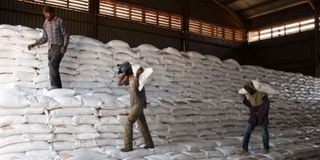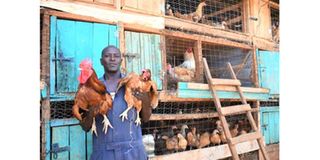Premium
Fertiliser subsidy project, land titles among big winners in Ruto’s agriculture plan

Workers arrange bags of subsidised fertiliser at the National Cereals and Produce Board depot in Elburgon, Nakuru County. The National Assembly’s Finance and National Planning Committee has accepted a proposal to retain a zero-rated tax on the transportation of sugarcane to factories as well as on fertiliser and other inputs used to manufacture fertiliser.
The fertiliser subsidy programme, land titling and development of the agriculture value chain are among the main focus areas in the agricultural sector in President William Ruto’s maiden budget.
The National Treasury has allocated Sh49.9 billion for food security programmes in the budget for the financial year 2023/24, a Sh3.1 billion increase from Sh46.8 billion in FY 2022/23.
Agriculture is the backbone of Kenya’s economy, and the sector’s performance has the single largest effect on the gross domestic product (GDP) growth each year, making key fiscal interventions in the sector one of Dr Ruto’s priorities in his first budget.
In the new budget, Sh5 billion has been allocated to cater for the distribution of subsidised fertiliser to thousands of farmers ahead of the short rains season in October.
The fertiliser subsidy is the only major subsidy on commodities retained by Dr Ruto in his first budget, having withdrawn the subsidies on fuel and maize flour during the current financial year.
“As part of the country’s long-term food security plan, the government, working with the private sector, will continue to subsidise fertiliser in order to make it available and improve productivity in counties,” said Treasury Cabinet Secretary Prof Njuguna Ndung’u in his inaugural budget speech on Thursday.
One of Dr Ruto’s major agriculture sector reforms in his first budget is in land titling, where he has allocated Sh1.2 billion for the processing and registration of title deeds and Sh2.6 billion for the settlement of landless individuals.
A further Sh755 million has been set aside for the digitisation of land registries while Sh138.3 million will be used for the construction of land registries.
“To ensure the legitimacy of land ownership, I propose to the National Assembly to effect the budget allocation of Sh1.2 billion for processing and registration of title deeds,” said Prof Ndung’u.
The Treasury has also allocated Sh8.6 billion for the National Agricultural Value Chain Development Project. The project seeks to increase market participation and value addition for targeted small-scale farmers in Kenya in 33 counties.
The exchequer has allocated Sh2.7 billion for the National Agricultural and Rural Inclusivity Project, Sh2.1 billion for the Kenya Cereal Enhancement Programme and 2.8 billion for emergency locust response.
Some Sh1.4 billion has been set aside for small-scale irrigation and value addition in the agricultural sector, Sh1.3 billion for food production and nutrition security and Sh596 million for crop diversification.
“To improve livestock production, I propose to the National Assembly to effect budget allocations of Sh3.7 billion to de-risking, inclusion and value enhancement of pastoral economies programme; Sh2.1 billion for Livestock Value Chain Support Project; Sh1.5 billion for Kenya Livestock Commercialisation Programme and Sh166 million for the Embryo Transfer Project,” said Prof Ndung’u.

National Treasury Cabinet Secretary Prof. Njuguna Ndung’u address a presser after Presenting the Budget at parliament buildings on June 15, 2023.
The Treasury has also made budget allocations of Sh2.6 billion for aquaculture business development, Sh3.5 billion for the Kenya Marine Fisheries and Socio-Economic Development Project, Sh1.2 billion for marine fish stock assessment and Sh580 million for capacity building in deep sea fishing.
Kenya’s agricultural sector, which supports millions of households across the value chain, has been struggling in recent years mainly due to adverse weather and increased cost of inputs which have reduced local production.
The sector shrunk by 0.4 per cent in 2021 according to the Economic Survey 2022, down from a growth of 5.2 per cent that was recorded in 2020 leading to a reduction in both crops and livestock performance.
During the period, maize production decreased from 42.1 million bags in 2020 to 36.7 million bags in 2021 with a similar trend recorded in the production of beans, coffee, wheat, and tea.
Win for maize, poultry farmers as prices soar
Maize prices have shot up across the country in a major win for farmers as they now fetch more money for their produce. Prices of Irish potatoes and eggs have also gone up, but farmers still complain of the high cost of farm inputs, which they say eats into their margins.
In Bomet and Kericho counties a 90-kilogram bag of maize is retailing for Sh6,900 due to shortages that have been experienced. Previously, the same quantity of cereal was sold for between Sh6,500 and Sh6,700 depending on the location.
On average, when supplies are stable, the 90kg bag retails for Sh6,000 in the region, according to dealers of the produce.
The story is the same in North Rift, where prices have remained high, at Sh6,200 per 90-kg bag.
Potato farming is the mainstay of farmers in most of the agriculture-rich parts of the South Rift region. In fact, Nakuru, Narok, Bomet, Kericho and Nyandarua are among the largest potato producers in the country.
Currently, Irish potato prices have risen in the South Rift region due to shortages that have been experienced, with a 50-kilogramme bag retailing at Sh2,500.
But lack of seeds has also bedevilled the region with those who are involved in bulking of the seeds having failed to plant on time as a result of drought.
The prolonged drought at the start of the year has been attributed to the rise in the prices by over Sh1,000
“Previously, the prices of a 50-kilogramme bag ranged from between Sh 1,200 and Sh 1,500, but the prevailing retail market price is Sh2,500,” said Ms Caroline Chebet, a trader at Kapkatet market in Kericho county.
Poultry rearing has also seen farmers fetch as high as Sh22 per egg, up from Sh15. But complaints of poor quality and expensive poultry feeds have dampened the prospects of farmers.

Justin Gitonga at his home in Mwangaza in Wabera ward, Isiolo North, where he rears chickens.
“The number of farmers investing in Kienyeji chicken has drastically reduced. The last time I got a supply of the eggs was in March 2023, and that one crate could not survive a day due to a high number of customers preferring that variety of eggs,” said Mr John Mwaura, a hotel operator in Ndaragwa.
In Ol Kalou Town, Janet Mwihaki, a distributor of the Kienyeji chicken eggs, has diversified to selling grade layer eggs and snacks to make ends meet.
“I was collecting up to 40 trays of eggs five years ago when I opened this business and I would sell everything the same day. But the supplies have declined, I hardly collect three trays in a day, and the prices are also prohibitive to the customers. The few farmers that still rear chicken sell a tray at Sh660, meaning I can only sell on retail at Sh25 per egg,” said Ms Mwihaki.
Reuben Kanja, a farmer from Ndaragwa, says the Kienyeji chicken supplied by breeders is also of low quality with unreliable laying trends.
“The chickens are supposed to lay at about five months old, but they now go for almost a year before they start producing eggs. The laying consistency is also poor, producing two to three eggs in a week, yet the cost of animal feed is expensive, and also of poor quality, forcing the farmers to incur an additional cost to buy supplements,” said the farmer.
Additional reporting by Vitalis Kimutai and Waikwa Maina





